Sheikh Lotfollah Mosque, Isfahan (Reviews, Plan, Dome)
Located on the eastern side of Isfahan’s iconic Naqsh-e Jahan Square, the Sheikh Lotfollah Mosque is one of Iran’s most exquisite architectural gems. Unlike most mosques built during the same period, the Sheikh Lotfollah Mosque was constructed specifically for the royal court, not for public worship, which is reflected in its intimate and serene design. The mosque’s design combines Islamic art with mathematical precision, creating a harmonious space that feels timeless and transcendent. Despite its relatively smaller size compared to the nearby Shah Mosque, it is no less impressive, attracting visitors from around the world who come to marvel at its architectural splendor, delicate tile work, and profound silence within. Let’s learn more about Sheikh Lotfollah Mosque, one of the top things to do in Isfahan.
About Sheikh Lotfollah Mosque
Sheikh Lotfollah Mosque built between 1603 and 1619 during the Safavid dynasty under the reign of Shah Abbas I, is a shining example of Islamic architecture at its finest. Its design is attributed to the renowned architect Mohammad Reza Isfahani, who infused traditional Persian elements with innovative design techniques.
The mosque’s name derives from Sheikh Lotfollah, a prominent religious scholar who was believed to have influenced the Safavid court and its spiritual life. The mosque’s unique position within Naqsh-e Jahan Square, situated at the corner of the square, reflects the significance of the royal court and its spiritual center.
The mosque’s layout is also distinct in that it does not include the typical courtyard or expansive open spaces found in most mosques. Instead, the structure features a compact prayer hall that leads into a small domed chamber, contributing to the feeling of enclosure and spiritual intimacy.
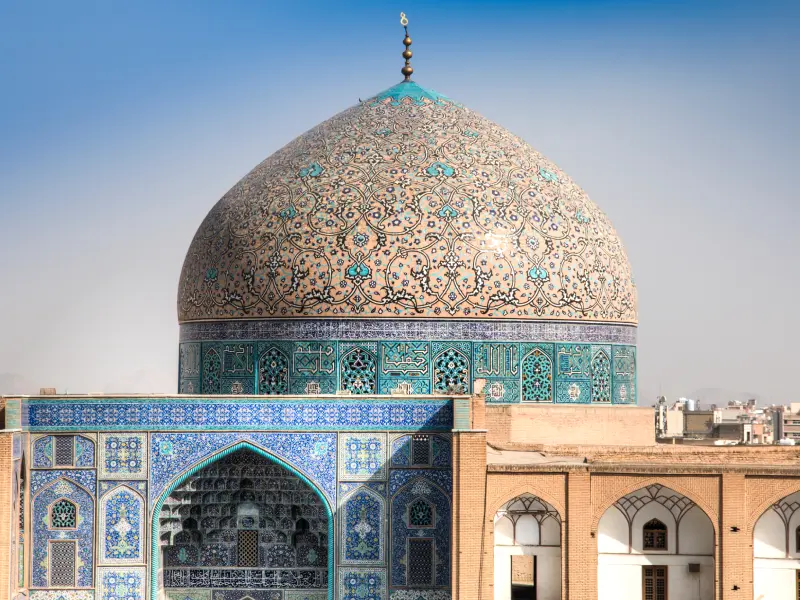
This design reflects the Safavid court’s desire for a space where worship could be both private and contemplative, creating an atmosphere ideal for personal reflection. As a result, the Sheikh Lotfollah Mosque is considered an architectural masterpiece, with its beauty and elegance continuing to leave a lasting impression on visitors to this day.
Sheikh Lotfollah Mosque History
The history of the Sheikh Lotfollah Mosque is intricately tied to the rise of the Safavid Empire and the vision of Shah Abbas I, the ruler who transformed Isfahan into the heart of his empire.
Shah Abbas I, who reigned from 1588 to 1629, sought to not only expand his empire but also to establish Isfahan as a center of art, culture, and Islamic devotion. The construction of the Sheikh Lotfollah Mosque began in the early years of his reign, around 1603, during a time when the Safavid Empire was experiencing a cultural renaissance.
The mosque was not meant to serve as a mosque for the general public but as a private place of worship for the royal court, which explains its relatively small size and intimate atmosphere. The mosque was completed in 1619, a period when the Safavid Empire was at the height of its power and influence.
The mosque stands as a symbol of the Safavid dynasty’s commitment to blending architectural innovation with religious devotion. Over the centuries, the mosque has been a key historical site, witnessing various phases of restoration and preservation.
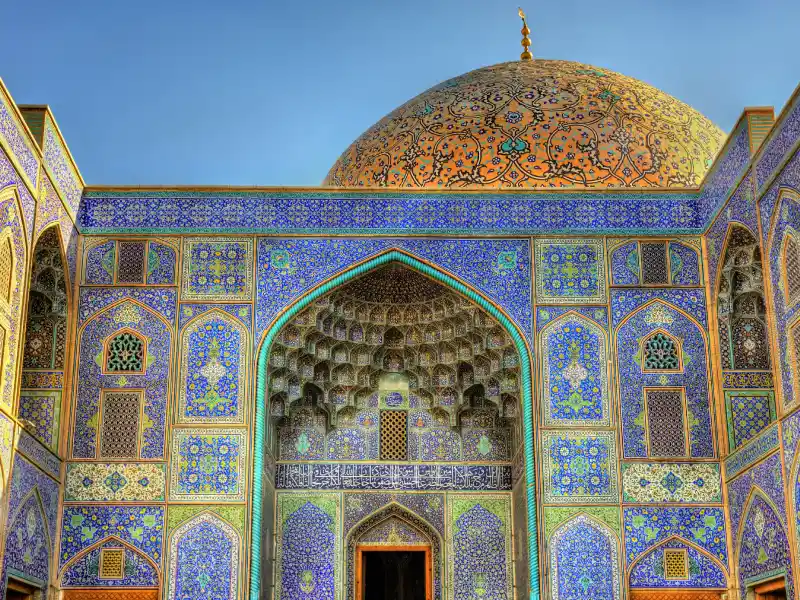
During the Qajar era, Isfahan suffered from a period of decline, and like many other Safavid structures, the Sheikh Lotfollah Mosque faced neglect. However, it has been lovingly restored in recent years, maintaining its status as one of Iran’s most celebrated cultural landmarks.
Today, the mosque not only serves as a place of historical importance but also as a spiritual and cultural site, attracting scholars, tourists, and worshippers alike. Its restoration and preservation efforts ensure that future generations can continue to admire the mosque’s architectural grandeur and rich history.
Sheikh Lotfollah Mosque Architecture
The architecture of Sheikh Lotfollah Mosque is often regarded as one of the finest examples of Safavid design, showcasing a blend of Persian artistic traditions with innovative engineering techniques. The mosque is a masterpiece of symmetrical proportions, with every element thoughtfully arranged to create a sense of harmony and spiritual elevation.
What sets the mosque apart from other Islamic structures of the period is its unique dome and its intricate tile work. The dome, which sits above the prayer hall, is one of the most breathtaking aspects of the mosque, with its stunning color shifts throughout the day, from soft cream hues in the morning to a warm golden tone as the sun sets.
The tile work on the dome and the surrounding walls features intricate geometric patterns, floral motifs, and Quranic inscriptions, all contributing to the mosque’s sense of otherworldliness.
The mosque’s minarets are relatively short, emphasizing the structure’s intimate feel and the entrance portal is relatively modest compared to the grandeur of other mosques in the square.
The mosque is adorned with mosaics that reflect the highest standards of Persian tile artistry, with each tile meticulously hand-painted. The use of arabesques and intricate calligraphy on the walls reinforces the mosque’s spiritual significance.
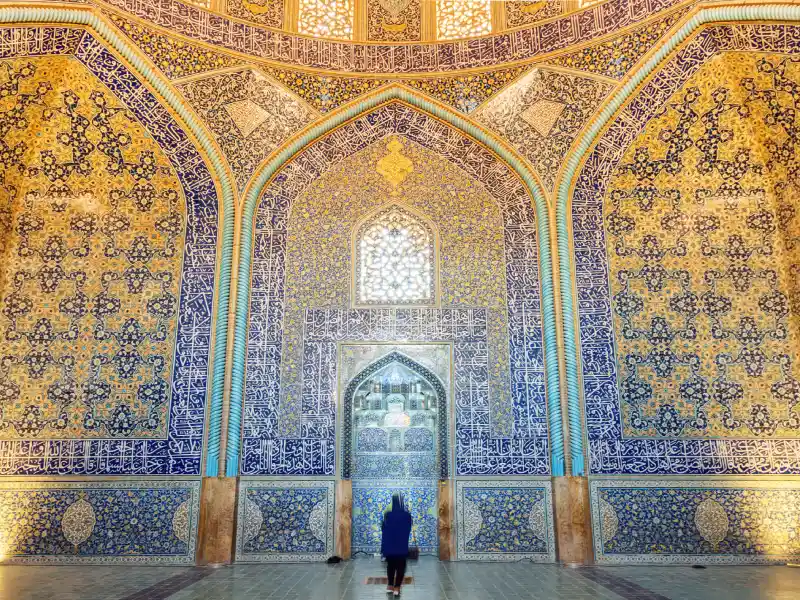
Additionally, the mosque’s use of light is a key architectural element. The natural light that filters through the small windows creates a mesmerizing effect, casting soft shadows on the tiles and enhancing the sense of tranquility. Overall, the design of Sheikh Lotfollah Mosque is a perfect example of how architecture can be both a visual delight and a spiritual experience, guiding visitors toward a sense of peace and reflection.
Sheikh Lotfollah Mosque Plan
The plan of Sheikh Lotfollah Mosque is an excellent demonstration of the Safavid architectural ethos, balancing both function and beauty in a relatively compact space. Unlike most mosques, which are designed around a central courtyard and open to the public, Sheikh Lotfollah’s plan focuses on intimacy and private worship.
The mosque does not feature the large, expansive courtyards commonly associated with grand mosques, nor does it have a large open space for a congregation. Instead, the structure is composed of a single, relatively small prayer hall that leads into a slightly elevated chamber beneath the mosque’s iconic dome. This design creates an aura of seclusion, reinforcing the mosque’s original purpose as a private sanctuary for the royal court.
The plan is also notable for its geometric precision. The central prayer hall is a square space, with a qibla wall that is oriented toward Mecca. The space is designed in such a way that the viewer’s attention is naturally drawn toward the mihrab, the niche indicating the direction of prayer.
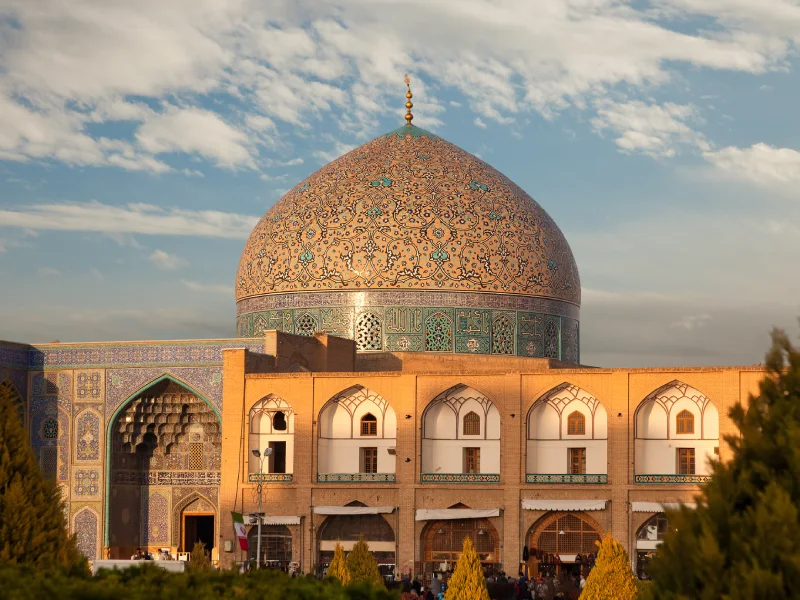
The structure’s proportions are in perfect harmony, with the height of the dome and the width of the hall in perfect balance. The use of arches, iwans, and vaults throughout the mosque’s layout enhances its sense of openness and creates a seamless flow from one space to the next.
The mosque’s relatively small scale, when compared to other mosques in the square, encourages contemplation and personal devotion, making it a unique and treasured architectural achievement in the heart of Isfahan.
Sheikh Lotfollah Mosque Ceiling
The ceiling of Sheikh Lotfollah Mosque is a true architectural marvel, reflecting both the ingenuity of Safavid builders and the spiritual aspirations of the time.
The centerpiece of the ceiling is the mosque’s iconic dome, which is renowned for its geometric complexity and stunning visual effects. The dome was constructed using traditional techniques but with a precision that was ahead of its time. The interior of the dome features intricate stucco work, with floral and geometric patterns that are skillfully crafted to provide an almost celestial quality to the space.
The use of light plays a key role in enhancing the dome’s beauty, as the natural light that filters through the small windows creates a play of shadow and light, enhancing the visual experience for visitors.
The ceiling is further adorned with a combination of colorful tiles and exquisite calligraphy that reflects the grandeur of the Safavid era. The swirling, almost hypnotic patterns on the dome’s surface are not just decorative but are meant to evoke a sense of divine presence.
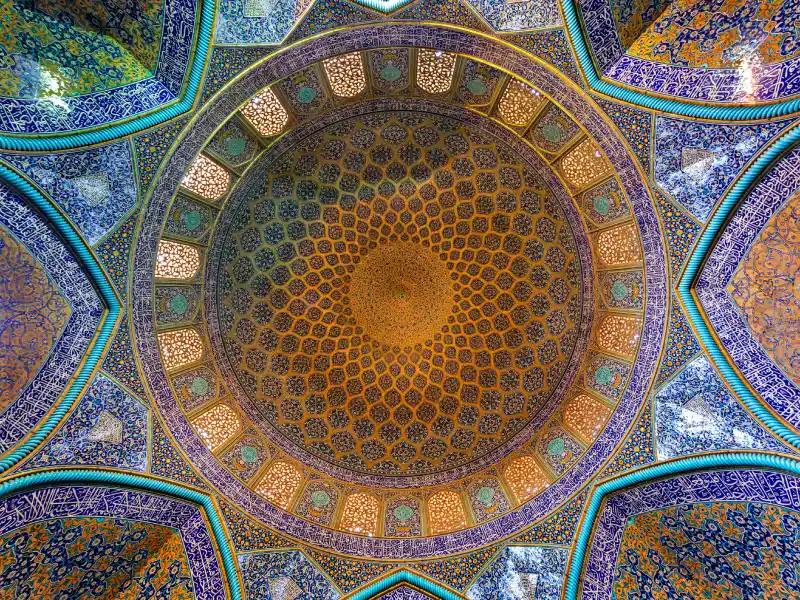
The ceiling of Sheikh Lotfollah Mosque, with its harmonious design and rich symbolism, is a true example of how architecture can transcend the physical to touch on the divine.
Sheikh Lotfollah Mosque Reviews
Visitors to the Sheikh Lotfollah Mosque often describe it as a serene, awe-inspiring place, with many praising its beauty and the tranquility it exudes. The mosque’s relatively small size compared to other structures in Naqsh-e Jahan Square creates an intimate atmosphere, which many visitors find inviting and peaceful.
The intricate tile work, particularly the stunning mosaics on the dome, leaves a lasting impression on those who enter. The mosque’s acoustics are also often highlighted, as the sound of prayer or the echo of footsteps within the prayer hall creates a deeply spiritual atmosphere. However, some visitors note that the mosque’s location in the busy square can sometimes detract
from the experience, as the surrounding hustle and bustle contrasts with the peaceful ambiance inside. Overall, the Sheikh Lotfollah Mosque is considered a must-visit site for anyone exploring the cultural and architectural treasures of Isfahan.
Sheikh Lotfollah Mosque Location
Situated in the heart of Isfahan’s famous Naqsh-e Jahan Square, Sheikh Lotfollah Mosque occupies a prime location that emphasizes its connection to the Safavid royal court. The mosque faces the square’s grand avenue, offering a direct view of the surrounding historic structures, including the Shah Mosque and Ali Qapu Palace.
Its location at the corner of the square gives it a unique position, allowing it to stand apart from the larger mosques, yet still be an integral part of the square’s architectural ensemble. This central position highlights its significance within the urban fabric of Isfahan, reinforcing the mosque’s role as a spiritual and cultural focal point in the city.
Last Words
The Sheikh Lotfollah Mosque is a true masterpiece of Persian architecture, blending intricate design with spiritual significance. From its humble beginnings as a royal chapel to its current status as a cultural and architectural icon, the mosque continues to captivate visitors with its beauty and serenity. Its unique design, detailed tile work, and harmonious layout reflect the excellence of Safavid craftsmanship and artistic achievement. Whether you are an architecture enthusiast or simply a visitor to Isfahan, the Sheikh Lotfollah Mosque offers an experience that transcends time and space, leaving a profound impression on all who visit.
Are you planning to travel to Iran and looking for an Iran resort? Consider Matinabad Eco-resort.

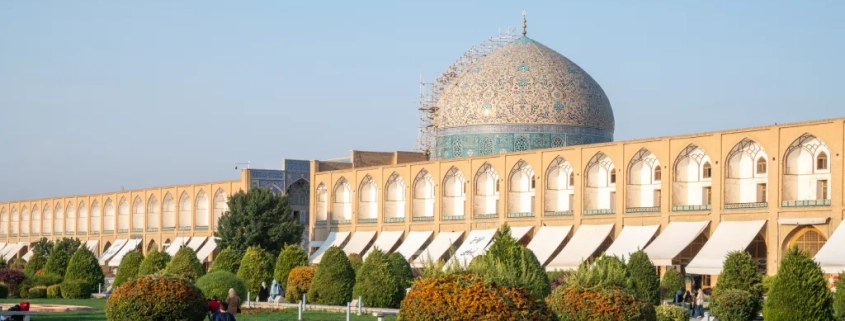



Leave a Reply
Want to join the discussion?Feel free to contribute!